Abstract
Acquired abnormalities of connective tissue metabolism in inflammatory diseases often persist when lesional tissue is maintained in in vitro culture. Although connective tissue cells are exposed to inflammatory cell-derived mediators in vivo and such mediators have been shown to alter connective tissue cell behavior, it is unclear whether the persistence of metabolic defects in vitro could result from remote in vivo exposure to these mediators. An in vitro model was used to test whether transient exposure of normal fibroblasts to inflammatory mediators could lead to metabolic alterations that persist during in vitro culture. Short-term exposure of human foreskin fibroblasts in vitro to supernates of mitogen-activated peripheral blood mononuclear cells led to persistent abnormalities of prostaglandin E2 (PGE2) metabolism. Fibroblasts previously exposed to mononuclear cell products synthesized more than twice as much PGE2 when stimulated compared with similarly stimulated but previously unexposed control fibroblasts of the same strain. The enhanced PGE2 synthesis persisted for as long as 20 wk and 19 cell generations after the original exposure to mononuclear cell products. Exposure of fibroblast populations to mononuclear cell products may, thus, lead to metabolite alterations that are still evident after multiple cell generations.
Full text
PDF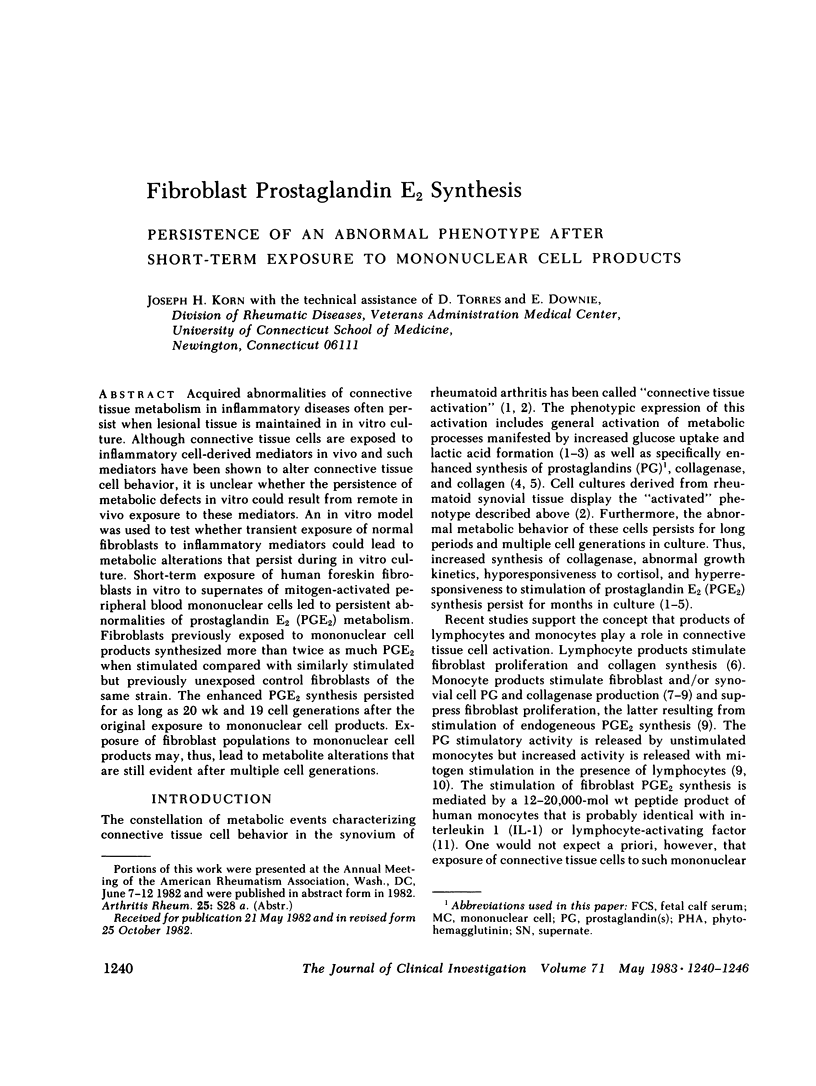
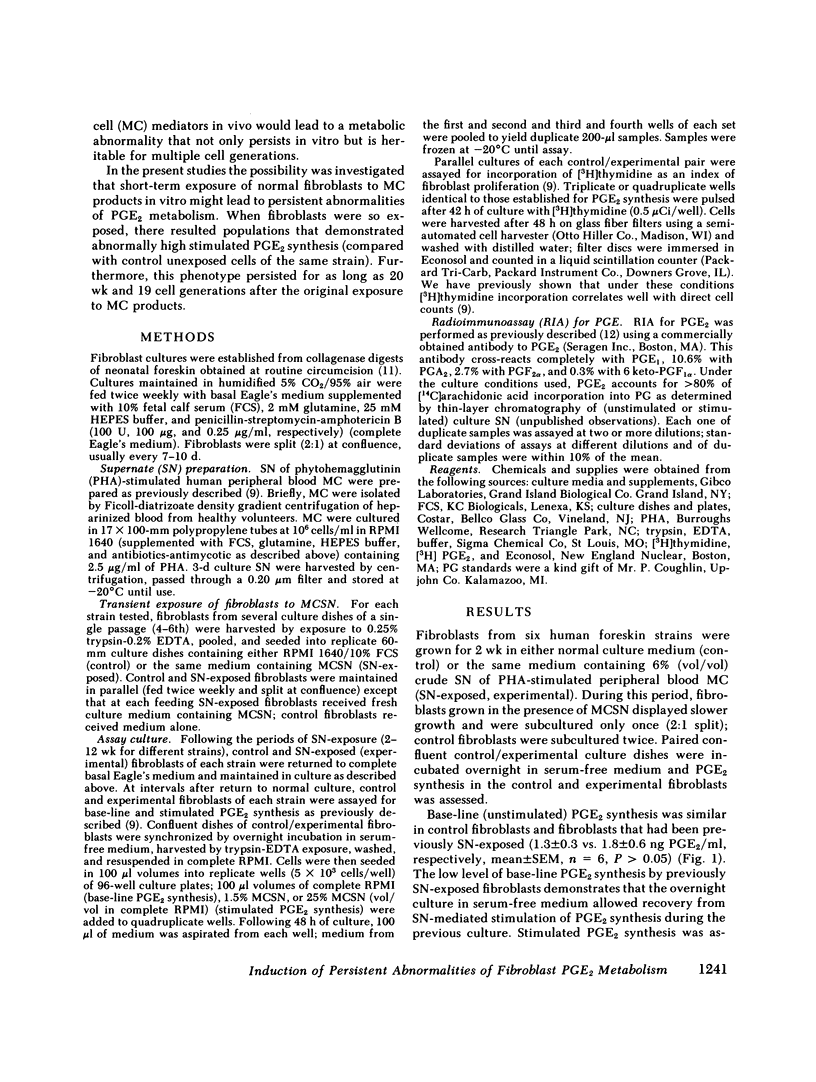
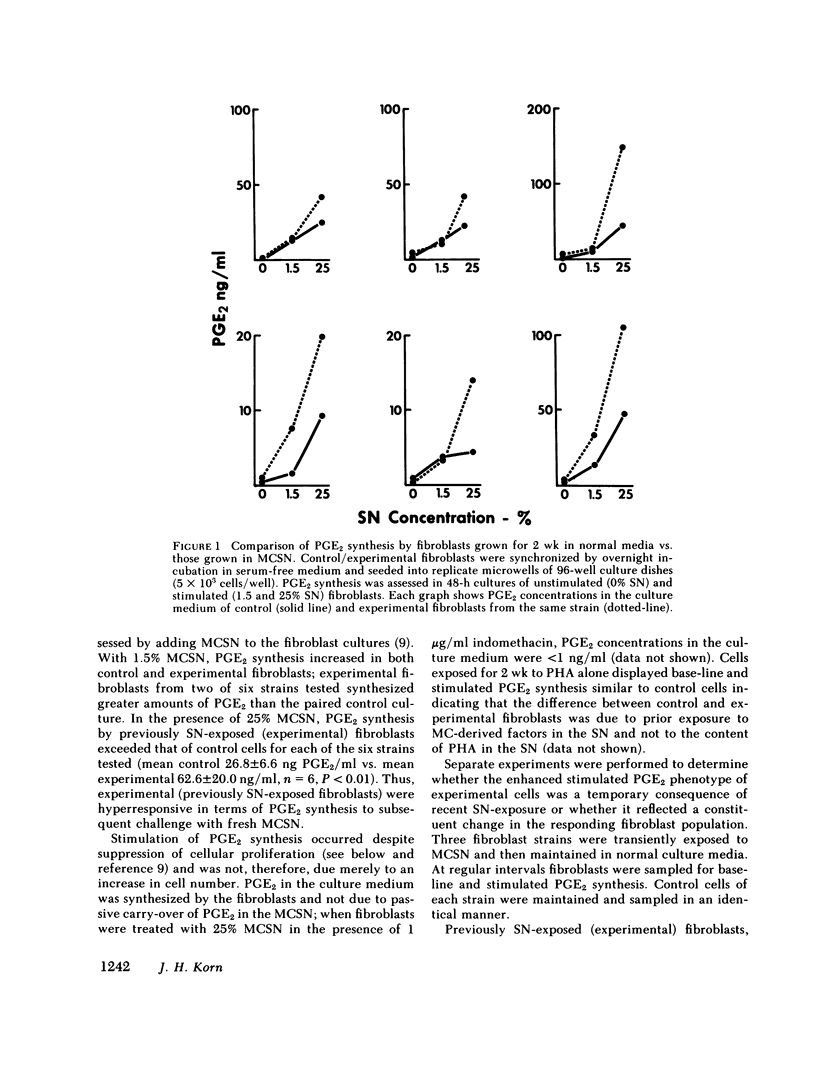
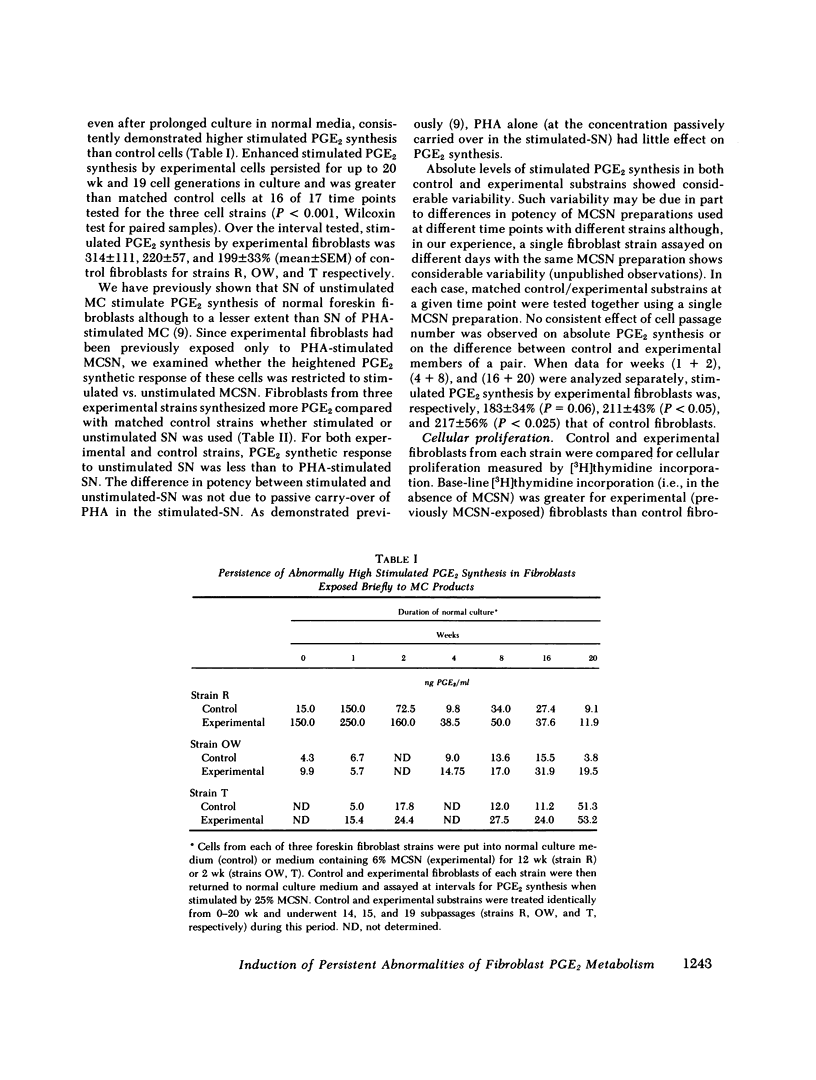


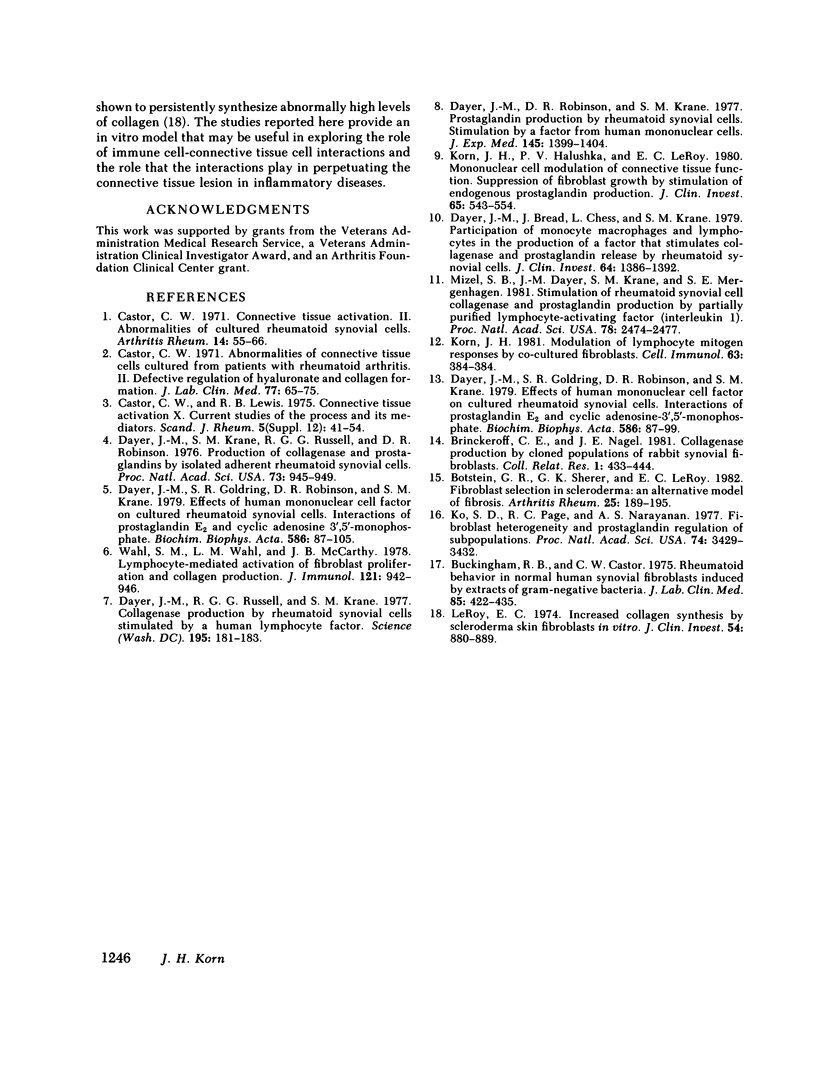
Selected References
These references are in PubMed. This may not be the complete list of references from this article.
- Botstein G. R., Sherer G. K., Leroy E. C. Fibroblast selection in scleroderma. An alternative model of fibrosis. Arthritis Rheum. 1982 Feb;25(2):189–195. doi: 10.1002/art.1780250212. [DOI] [PubMed] [Google Scholar]
- Brinckerhoff C. E., Nagel J. E. Collagenase production by cloned populations of rabbit synovial fibroblasts. Coll Relat Res. 1981 Sep;1(5):433–444. doi: 10.1016/s0174-173x(81)80027-1. [DOI] [PubMed] [Google Scholar]
- Buckingham R. B., Castor C. W. Rheumatoid behavior in normal human synovial fibroblasts induced by extracts of Gram-negative bacteria. J Lab Clin Med. 1975 Mar;85(3):422–435. [PubMed] [Google Scholar]
- Castor C. W. Connective tissue activation. II. Abnormalities of cultured rheumatoid synovial cells. Arthritis Rheum. 1971 Jan-Feb;14(1):55–66. doi: 10.1002/art.1780140108. [DOI] [PubMed] [Google Scholar]
- Castor C. W., Dorstewitz E. L., Rowe K., Ritchie J. C. Abnormalities of connective tissue cells cultured from patients with rheumatoid arthritis. II. Defective regulation of hyaluronate and collagen formation. J Lab Clin Med. 1971 Jan;77(1):65–75. [PubMed] [Google Scholar]
- Castor C. W., Lewis R. B. Connective tissue activation. X. Current studies of the process and its mediators. Scand J Rheumatol Suppl. 1975;12:41–54. [PubMed] [Google Scholar]
- Dayer J. M., Bréard J., Chess L., Krane S. M. Participation of monocyte-macrophages and lymphocytes in the production of a factor that stimulates collagenase and prostaglandin release by rheumatoid synovial cells. J Clin Invest. 1979 Nov;64(5):1386–1392. doi: 10.1172/JCI109596. [DOI] [PMC free article] [PubMed] [Google Scholar]
- Dayer J. M., Graham R., Russell G., Krane S. M. Collagenase production by rheumatoid synovial cells: stimulation by a human lymphocyte factor. Science. 1977 Jan 14;195(4274):181–183. doi: 10.1126/science.188134. [DOI] [PubMed] [Google Scholar]
- Dayer J. M., Krane S. M., Russell R. G., Robinson D. R. Production of collagenase and prostaglandins by isolated adherent rheumatoid synovial cells. Proc Natl Acad Sci U S A. 1976 Mar;73(3):945–949. doi: 10.1073/pnas.73.3.945. [DOI] [PMC free article] [PubMed] [Google Scholar]
- Dayer J. M., Robinson D. R., Krane S. M. Prostaglandin production by rheumatoid synovial cells: stimulation by a factor from human mononuclear Cells. J Exp Med. 1977 May 1;145(5):1399–1404. doi: 10.1084/jem.145.5.1399. [DOI] [PMC free article] [PubMed] [Google Scholar]
- Ko S. D., Page R. C., Narayanan A. S. Fibroblast heterogeneity and prostaglandin regulation of subpopulations. Proc Natl Acad Sci U S A. 1977 Aug;74(8):3429–3432. doi: 10.1073/pnas.74.8.3429. [DOI] [PMC free article] [PubMed] [Google Scholar]
- Korn J. H., Halushka P. V., LeRoy E. C. Mononuclear cell modulation of connective tissue function: suppression of fibroblast growth by stimulation of endogenous prostaglandin production. J Clin Invest. 1980 Feb;65(2):543–554. doi: 10.1172/JCI109698. [DOI] [PMC free article] [PubMed] [Google Scholar]
- Korn J. H. Modulation of lymphocyte mitogen responses by cocultured fibroblasts. Cell Immunol. 1981 Sep 15;63(2):374–384. doi: 10.1016/0008-8749(81)90016-2. [DOI] [PubMed] [Google Scholar]
- LeRoy E. C. Increased collagen synthesis by scleroderma skin fibroblasts in vitro: a possible defect in the regulation or activation of the scleroderma fibroblast. J Clin Invest. 1974 Oct;54(4):880–889. doi: 10.1172/JCI107827. [DOI] [PMC free article] [PubMed] [Google Scholar]
- Mizel S. B., Dayer J. M., Krane S. M., Mergenhagen S. E. Stimulation of rheumatoid synovial cell collagenase and prostaglandin production by partially purified lymphocyte-activating factor (interleukin 1). Proc Natl Acad Sci U S A. 1981 Apr;78(4):2474–2477. doi: 10.1073/pnas.78.4.2474. [DOI] [PMC free article] [PubMed] [Google Scholar]
- Wahl S. M., Wahl L. M., McCarthy J. B. Lymphocyte-mediated activation of fibroblast proliferation and collagen production. J Immunol. 1978 Sep;121(3):942–946. [PubMed] [Google Scholar]


